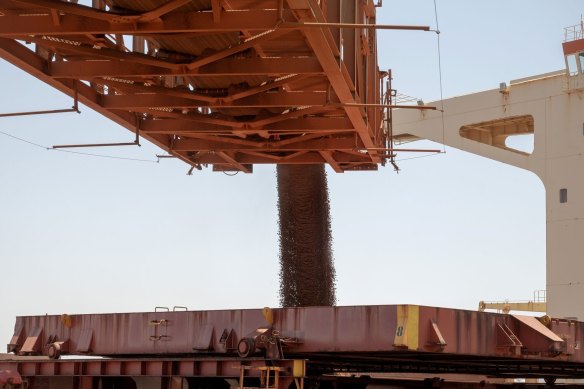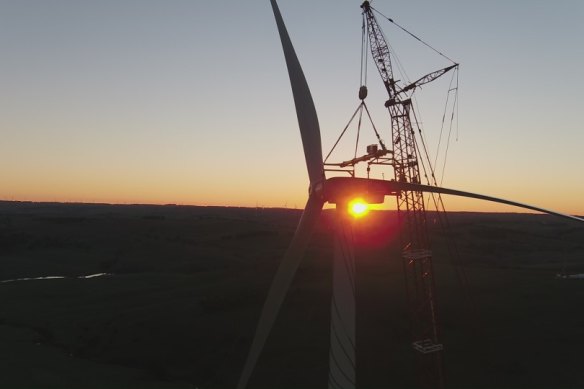Aluminium price puts dent in Rio Tinto’s earnings
Mining giant Rio Tinto will become Australia’s largest user of renewable energy as it pushes ahead with decarbonising its operations even as lower global prices for key commodities put a $US1.5 billion ($2.3 billion) dent its earnings.
Price declines in key commodities offset growth in the mining giant’s all-important Pilbara iron ore earnings. Rio’s underlying full-year earnings fell 12 per cent compared with the previous year, down to $US11.8 billion, the company reported on Wednesday.

While ore shipped from the Pilbara fetched a 2 per cent higher price in 2023 compared with 2022, the aluminium price tumbled 18 per cent and the price of Rio’s other main product, copper, dipped 3 per cent. Prices fell as supply improved, outpacing modest demand, Rio said.
The miner said inflationary pressures were easing.
Diesel costs for its heavy iron ore machinery are down as is energy used by its alumina refineries and aluminium smelters, along with fuel prices in its marine business, all of which helped support earnings.
Rio reported a 2023 calendar year profit of $US10.05 billion and will pay out a full-year ordinary dividend of $US4.35 a share, about 12 per cent lower than the previous year. The $US7.1 billion in dividends is in line with Rio’s 60 per cent payout ratio of underlying earnings over the past eight years.
“In 2023, we lifted our overall copper equivalent production by over 3 per cent and delivered resilient financial results, with underlying EBITDA [earnings before interest, taxes, depreciation, and amortisation] of $US23.9 billion, free cash flow of $US7.7 billion and underlying earnings of $US11.8 billion, after taxes and government royalties of $US8.8 billion,” chief executive Jakob Stausholm said.
Stausholm said Rio’s major market, China, was robust and growing, and while the property sector contracted last year, demand for metals for infrastructure grew.
The Anglo-Australian company is building a lithium mine in Argentina and has plans for another in Serbia. Stausholm said while the sector was volatile, it was long-term prices that mattered, and Chinese battery manufacturers were using more lithium and less nickle and cobalt.
However, he was not “super-excited” about acquisitions in the sector, saying the share price of lithium producers was still at the high end, despite recent falls.
The mining giant said on Wednesday morning, ahead of its full-year results, that it would back a major wind farm to help power its energy-intensive aluminium smelter and refineries in Gladstone, making it the largest industrial user of renewable energy in Australia.

Under Rio’s new renewable power purchase agreement for its Queensland operations, it will buy 80 per cent of the electricity generated over the next 25 years by Windlab’s planned 1.4 gigawatt Bungaban project.
Windlab is majority-owned by Andrew Forrest’s Beach Energy and is in early development of the giant wind farm about 40 kilometres outside Wandoan, a town about 290 kilometres south-west of Gladstone. Its project still needs development approvals and grid connections.
Rio’s two alumina refineries and its Boyne aluminium smelter in Gladstone are among the country’s most power-hungry manufacturing sites.
The agreement follows another signed by the miner in January to buy the entire output of a 1.1 gigawatt solar farm Upper Calliope, also near Gladstone. That 25-year deal with European Energy has the potential to lower Rio Tinto’s operating carbon emissions by 1.8 million tonnes a year.
“We’re moving from strategy and target setting to real action and doing so in a way that makes real business sense,” Stausholm said.
Combined, both projects give the miner 2.2 gigawatts of renewable power, enough to reduce emissions by about 5 million tonnes a year and provide about 12 per cent of the company’s current electricity use in Queensland.
Windlab chief executive John Martin said large-scale renewable energy projects such as Bungaban will shore up Queensland’s traditional industries, particularly in minerals and advanced processing, which employ thousands.
The company said non-executive director Simon McKeon would step down from the board at May’s annual general meeting.
The Business Briefing newsletter delivers major stories, exclusive coverage and expert opinion. Sign up to get it every weekday morning.
Most Viewed in Business
Source: Thanks smh.com